Canadian Cannabis Survey 2021: Summary
On this page
Introduction
The Cannabis Act is a national framework aimed to control the production, distribution, sale and possession of cannabis in Canada. The legislation and accompanying regulations came into force on October 17, 2018. To evaluate the impact of the Cannabis Act, data are required to better understand how Canadians view and use cannabis. These data will also support development of policy and program initiatives, including public education and awareness activities.
In order to obtain in-depth information, Health Canada developed and implemented the Canadian Cannabis Survey (CCS). The aim of the CCS is to obtain detailed information about the habits of people who use cannabis and behaviours relative to cannabis use.
The CCS started in 2017 and is conducted annually. It examines patterns of use, such as the quantities of cannabis consumed and the use of cannabis for medical purposes; the cannabis market, such as sources of cannabis and pricing; and issues of public safety, such as impaired driving. Survey content is reviewed annually and modified to address any identified gaps in the data.
The 2021 CCS included additional questions such as:
- exposure to the cannabis consumer information sheet
- home growing of cannabis plants inside and outside the home
- knowledge about potential harms from use of cannabis topicals
- knowledge of when it is safe to drive after ingesting (eating/drinking) cannabis products
- changes in cannabis use in the context of Coronavirus disease 2019 (COVID-19) pandemic
Results by theme
Results from the 2021 survey are presented by theme. Comparisons to the 2020 CCS data were made where applicable. Note that some questions were changed between 2020 and 2021 cycles.
All reported increases and decreases in the text below are statistically significant changes (meaning that they are not likely to have occurred by chance alone). To improve readability, the words “statistically significant” will not be repeated. Similarly, at times the text will state that the proportion is “unchanged” or not different between groups, even though the numbers are not identical. This occurs when the difference between numbers is not statistically significant.
Definitions
- Cannabis use includes using cannabis in its dry form or when mixed or processed into another product, such as an edible, a concentrate, including hashish, a liquid, or other product.
- Cannabis use for non-medical purposes is defined as use for a range of non-medical reasons (such as, socially for enjoyment, pleasure, amusement or for spiritual, lifestyle and other non-medical reasons).
- Cannabis use for medical purposes is defined as use to treat a disease/disorder or to improve symptoms associated with a disease/disorder.
Detailed results tables have been published on the Library and Archives website. A summary of the key results by theme is provided below.
In this section
- Knowledge, opinions and behaviours
- Cannabis use and products used
- Sources and purchasing
- Driving and cannabis
- Cannabis for medical purposes
- Featured topic: Data over the past 4 years
Knowledge, opinions and behaviours
Canadians were asked questions about their knowledge and opinions related to cannabis. Topics included:
- knowledge/beliefs about harms related to cannabis
- access to trustworthy information
- exposure to health warning messages and public health messaging
- cannabis use in the home
- social acceptability of cannabis and other substance use
- perceived risk of using cannabis and other substances
- opinions on whether cannabis use can be habit forming
Knowledge/beliefs about harms related to cannabis
Canadians were asked if they know or believe cannabis smoke can be harmful, if daily or almost daily cannabis use can increase the risk of mental health problems, and whether teenagers are at greater risk of harm from cannabis use than adults (Figure 1). For all of these harms, the majority of people reported they believe these risks to be true.
Figure 1: Knowledge or beliefs regarding cannabis-associated harms, 2021
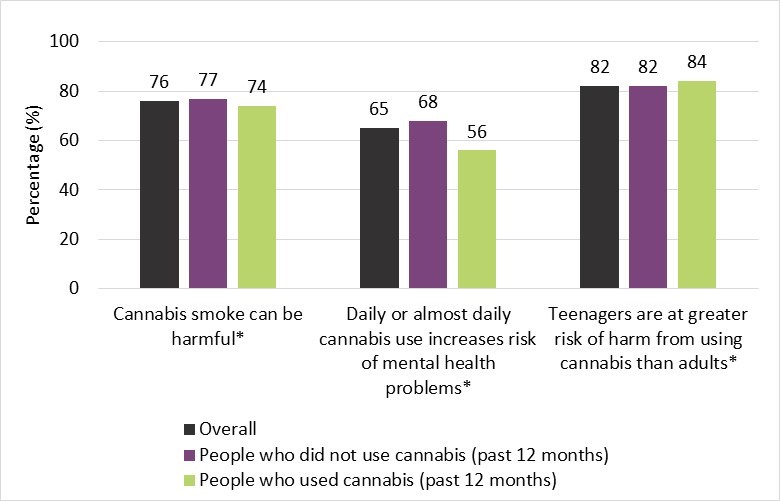
Text description
| Cannabis smoke can be harmfulFigure 1 Footnote * | Daily or almost daily cannabis use increases risk of mental health problemsFigure 1 Footnote * | Teenagers are at greater risk of harm from using cannabis than adultsFigure 1 Footnote * | |
|---|---|---|---|
| Overall | 76% | 65% | 82% |
| People who did not use cannabis (past 12 months) | 77% | 68% | 82% |
| People who used cannabis (past 12 months) | 74% | 56% | 84% |
|
|||
Access to trustworthy information
People were asked if they felt they had access to enough trustworthy information about the health risks of cannabis use to make informed decisions. Most people (73%) reported somewhat or strongly agreeing that they had enough trustworthy information, a decrease from 2020 (77%). This was more common among those who used cannabis in the past 12 months (87%) than among those who had not used cannabis (69%). Only 8% of Canadians were aware of the Lower-Risk Cannabis Use Guidelines, and a further 13% were not sure if they had heard of the Guidelines, both decreases from 2020 (10% and 16% respectively). Among those who had used cannabis in the past 12 months, 12% were aware of the Lower-Risk Cannabis Use Guidelines (unchanged from 2020) and a further 12% were not sure if they had heard of the Guidelines, a decrease from 15% in 2020.
Exposure to health warning messages and consumer information sheet
Canadians were asked if they had seen the health warning messages on cannabis products/packages or on Health Canada's website. Thirty percent (30%) of people reported they had seen the warnings, a decrease from 2020 (38%) and a further 18% reported they were not sure, also a decrease from 2020 (27%). Among those who used cannabis in the past 12 months, a lower percentage (64%) reported having seen the warnings compared to 2020 (68%). Of all those who had seen the warnings, over half (57%) reported the warnings increased their knowledge of the harms related to cannabis use at least somewhat, unchanged from 2020. Of those who had not seen the warnings, 72% felt that they sufficiently knew the harms related to cannabis at least somewhat, also unchanged from 2020.
New in the 2021 survey, Canadians were asked if they had seen the cannabis consumer information sheet either with their purchase, displayed at a retailer, or on the Health Canada website. Only 10% of Canadians reported seeing the cannabis consumer information sheet at one or more location, and a further 14% were unsure if they had seen the sheet. Among those who used cannabis in the past 12 months 21% reported having seen the information sheet. Of all those who had seen the information sheet, the majority (70%) reported the sheet increased their knowledge of the harms related to cannabis use at least somewhat.
Exposure to education campaigns, public health or safety messages
Canadians were asked if they had seen or heard education campaigns, public health or safety messages about cannabis in various locations since the Cannabis Act came into force. Canadians could select more than one location if they had seen or heard these messages in multiple locations. Figure 2 shows the most common locations. For all locations, those who used cannabis in the past 12 months were more likely to report having seen these messages.
Figure 2: Location1 of exposure to education campaigns, public health or safety messages about cannabis, among all Canadians, 2021
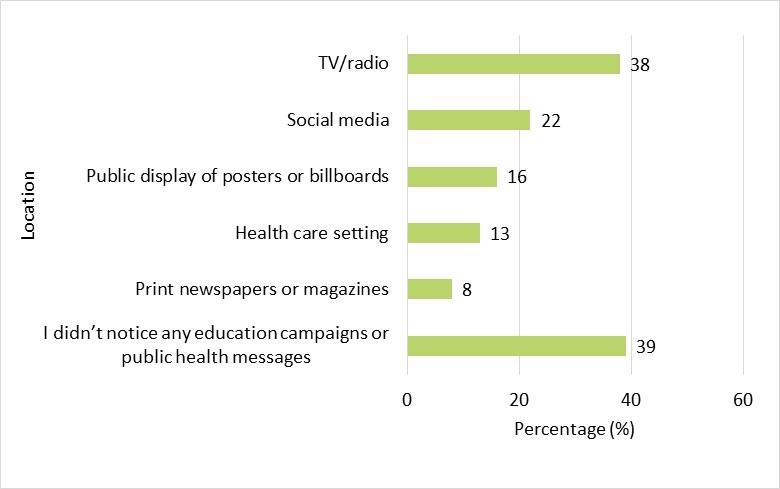
Text description
| LocationFigure 2 Footnote 1 | Percentage |
|---|---|
| TV/radio | 38% |
| Social media | 22% |
| Public display of posters or billboards | 16% |
| Health care setting | 13% |
| Print newspapers or magazines | 8% |
| I didn't notice any education campaigns or public health messages (exclusive) | 39% |
|
|
Of those who saw or heard these messages, 77% reported that the information was credible or believable, an increase from 2020 (73%). The most common messages observed related to driving and cannabis use (79%), cannabis' impact on adolescent/young adult developing brains (39%), cannabis' impact on mental health (25%) and dependence and cannabis use (23%). For messages related to driving and cannabis use, cannabis use while pregnant or breastfeeding, cannabis' impact on developing brains, and onset/duration of effect from cannabis edibles, those who used cannabis in the past 12 months were more likely to report having seen these messages than those who did not use cannabis. There were no differences between those who used cannabis and those who did not for the other topics.
Home growing of cannabis and preparation of cannabis edibles/drinks
Canadians were asked if anyone had grown cannabis plants in or around home in the past 12 months. Overall, 6% reported that plants had been grown in or around home; among those who had used cannabis in the past 12 months it was 15%, both unchanged from 2020. Among those who reported plants currently being grown in or around their residence, the average number of plants was 3.6, unchanged from 2020. New in 2021, we also asked about the number of plants that had been grown inside and outside the home in the past 12 months. For those who reported growing outside the average number of plants was 3.1. For those who reported growing inside the home the average number of plants was also 3.4.
Canadians were asked if anyone had prepared cannabis edibles or beverages in or around home in the past 12 months. Overall, 7% reported preparation of cannabis edibles or beverages in their home, unchanged from 2020. Among those who had used cannabis in the past 12 months it was 22%, an increase from 2020 (19%).
Exposure to second-hand smoke
Canadians were asked about locations of exposure to second-hand cannabis smoke or vapour in the past 30 days. The most common location was a public place, with 33% of Canadians reporting exposure, a decrease from 36% in 2020. This was similar among both those who used cannabis in the past 12 months and those that did not. Overall, 17% of Canadians reported exposure to second-hand smoke in the home, a decrease from 19% in 2020, and 5% were exposed in a car, unchanged from 2020. A higher proportion of those using cannabis in the past 12 months reported exposure to second-hand cannabis smoke or vapour in the home (38%) and in a car (9%) compared to people who did not use cannabis in the past 12 months (10% and 3%, respectively). Exposure at a workplace or school (5%) was less common, among both those who used cannabis in the past 12 months and those that did not.
Social acceptability
Canadians were asked about the social acceptability of using various products occasionally and regularly. Of the proposed substances (alcohol, tobacco and cannabis), the most socially acceptable product to use, whether occasionally or regularly, was alcohol, followed by cannabis and tobacco (Figure 3). The social acceptability of the occasional use of e-cigarettes and eating or vaping cannabis increased slightly compared to 2020.
Figure 3: Social acceptability of using various products, among all Canadians, 2021
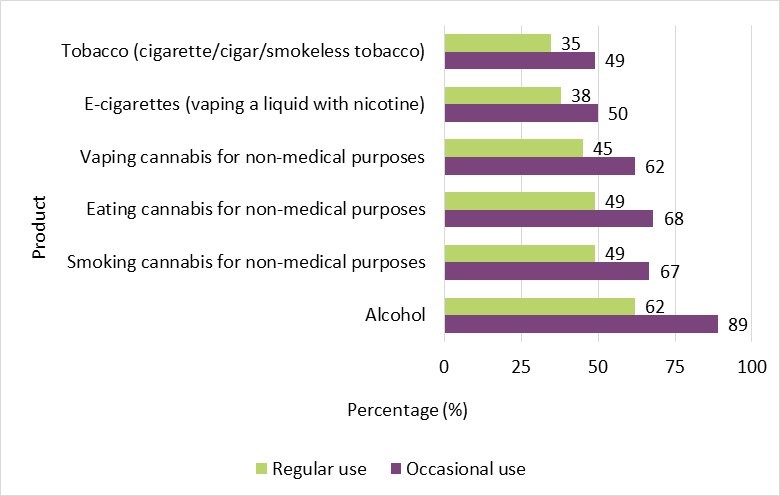
Text description
| Product | Percentage (%) responding somewhat or completely acceptable | |
|---|---|---|
| Regular use | Occasional use | |
| Tobacco (cigarette, cigar, smokeless tobacco) | 35% | 49% |
| E-cigarettes (vaping a liquid with nicotine) | 38% | 50% |
| Vaping cannabis for non-medical purposes | 45% | 62% |
| Eating cannabis for non-medical purposes | 49% | 68% |
| Smoking cannabis for non-medical purposes | 49% | 67% |
| Alcohol | 62% | 89% |
Social acceptability of occasional or regular use of alcohol, tobacco and cannabis was higher among people who indicated using cannabis in the past 12 months compared to those who did not report cannabis use. This pattern was also seen in 2020.
Perceived risks of using various substances
Canadians were asked how much they thought a person risked harming themselves by using various products once in a while and on a regular basis. Perceived risk was determined using a 4-point Likert scale, which had the following categories: no risk, slight risk, moderate risk, great risk and “don’t know”.
In general, the majority of people felt that occasional use of alcohol or cannabis had no risk or slight risk. Whereas smoking tobacco and using an e-cigarette with nicotine once in a while was seen as having moderate or great risk by the majority of people.
When asked about the use of these substances on a regular basis, the majority of people perceived either moderate or great risk for smoking tobacco (95%), followed by using an e-cigarette with nicotine (89%), drinking alcohol (75%), vaping cannabis (75%), smoking cannabis (73%), and eating cannabis (66%), all unchanged from 2020.
Those who used cannabis in the past 12 months had a lower percentage reporting moderate or great perceived risk from regular use of the aforementioned products than those who had not used cannabis, except for smoking tobacco on a regular basis. The difference in the percentage reporting moderate or great perceived risk was much smaller for the regular use of alcohol, tobacco, and e-cigarettes with nicotine compared to smoking, eating or vapourizing cannabis (Figure 4).
Figure 4: Perceived risk of various behaviours on a regular basis, 2021
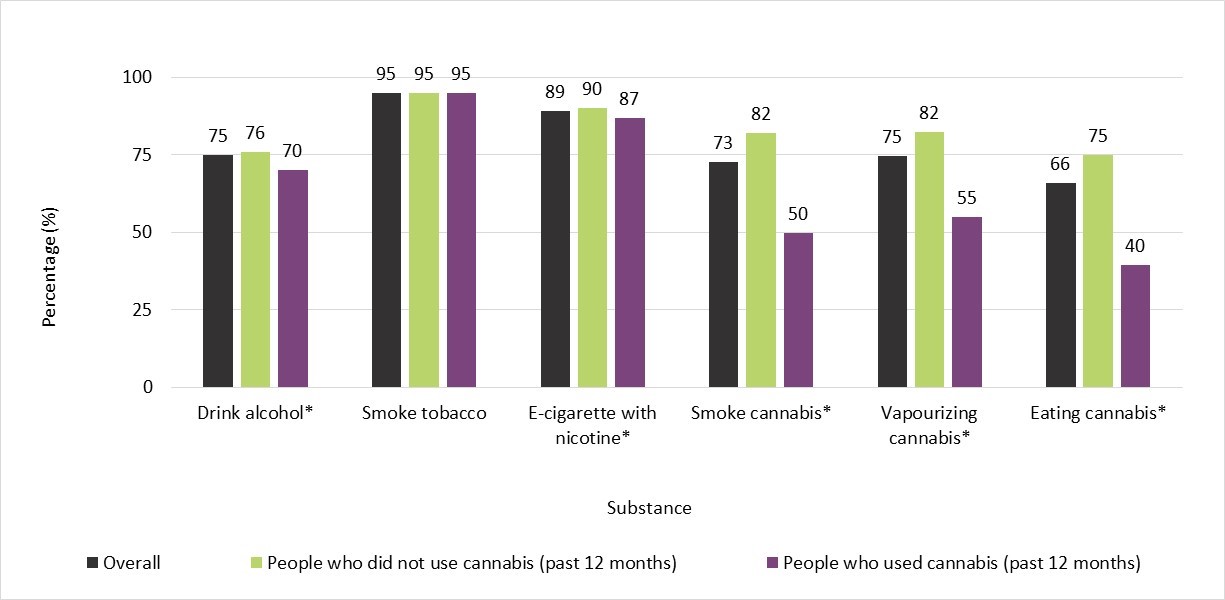
Text description
| Substance | Percentage responding moderate or great risk | ||
|---|---|---|---|
| Overall | People who did not use cannabis (past 12 months) | People who used cannabis (past 12 months) | |
| Drink alcoholFigure 4 Footnote * | 75% | 76% | 70% |
| Smoke tobacco | 95% | 95% | 95% |
| E-cigarette with nicotineFigure 4 Footnote * | 89% | 90% | 87% |
| Smoke cannabisFigure 4 Footnote * | 73% | 82% | 50% |
| Vapourizing cannabisFigure 4 Footnote * | 75% | 82% | 55% |
| Eating cannabisFigure 4 Footnote * | 66% | 75% | 40% |
|
|||
Pregnancy and breastfeeding
Canadians were asked whether they agreed that it is okay to use cannabis when pregnant or breastfeeding. Overall, the majority (87%) of Canadians did not agree, unchanged from 2020. Among those who used cannabis in the past 12 months, 83% did not agree (unchanged from 2020), compared to 88% of those who did not use cannabis (a decrease from 90% in 2020).
Females aged 16 to 50 who had given birth in the past 5 years were asked about cannabis use during their last pregnancy. Overall, 95% did not use cannabis once they learned they were pregnant with their last child. Among those who breastfed, 92% did not use cannabis while breastfeeding their last child. Both were unchanged from 2020.
Opinions on cannabis impairment
Canadians were asked about their opinions on cannabis impairment. Overall, 41% of people thought consuming cannabis products with lower levels of THC did not lead to greater impairment (a decrease from 45% in 2020), while 19% thought it did (an increase from 13% in 2020), and 39% were not sure (a decrease from 42% in 2020). Among people who reported using cannabis in the past 12 months, the majority (70%, a decrease from 73% in 2020) felt products with lower levels of THC did not lead to greater impairment, while 9% (an increase from 5% in 2020) thought it did and 21% were not sure (unchanged).
Overall, 50% of people thought it could take up to four hours to feel the full effects of eating or drinking cannabis (a decrease from 52% in 2020), while 10% did not (unchanged), and 40% were not sure (an increase from 38% in 2020). Among people who reported using cannabis in the past 12 months, the majority (75%) thought it could take up to four hours, while 14% did not, and 12% were not sure, all unchanged from 2020.
Overall, 10% (unchanged from 2020) of people thought the effects of inhaling cannabis were longer-lasting than eating/drinking cannabis products, while 36% did not (a decrease from 40% in 2020), and 54% were not sure (an increase from 51% in 2020). Among people who reported using cannabis in the past 12 months, only 7% thought the effects of inhaling cannabis were longer-lasting than eating/drinking cannabis products, while the majority (72%) did not, and 21% were not sure, all unchanged from 2020.
Opinions on whether cannabis use can be habit forming
Overall, 89% of people thought that using cannabis could be habit forming, unchanged from 2020. The majority of people (93%) who reported using cannabis in the past 12 months thought cannabis could be habit forming (unchanged from 2020). A majority (88%) of those who did not use cannabis also thought cannabis could be habit forming, a decrease from 2020 (89%).
Cannabis use and products used
Canadians who reported using cannabis for non-medical purposes were asked detailed questions about their use of cannabis. Topics included:
- age of initiation of cannabis use
- methods of consumption
- types of cannabis products used and frequency
- typical THC to CBD ratio of products
- typical use in terms of number of hours and amount used per day
- where cannabis is stored inside the home
Cannabis use
Canadians were asked about their cannabis use within the past 12 months. Twenty-five percent (25%) of people reported having used cannabis in the past 12 months, a decrease from 27% in the previous cycle. Provincial/territorial estimates ranged from 17% to 38%. Note that due to the data collection methodology, the CCS may provide general population prevalence estimates for cannabis use that are higher than other Canadian surveys.
Past 12-month use in Canadians of various demographic groups
People between the ages of 16 to 24 years reported cannabis use in the past year at a percentage that was approximately double that of those 25 years and older. Males reported a higher percentage of cannabis use in the past year than females. Reported past 12-month use decreased between 2020 and 2021 among those 16 to 19 and 20 to 24 years of age and among males (Figure 5).
Figure 5: Past 12-month cannabis use, by sex and age group, 2020 to 2021
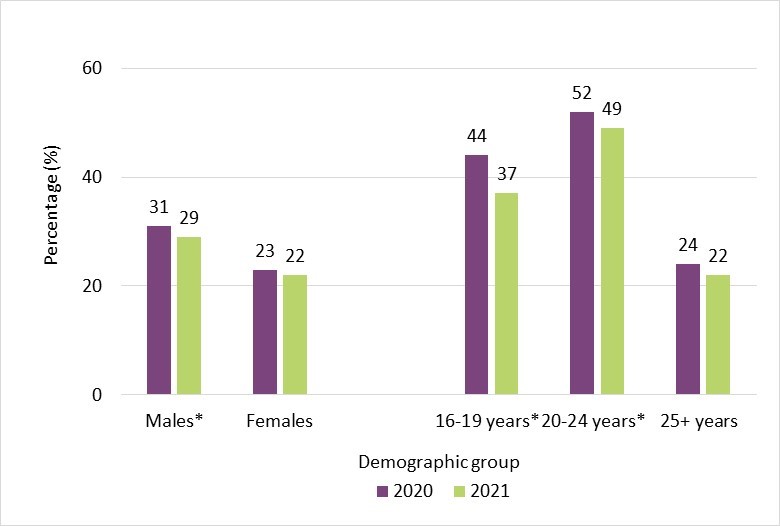
Text description
| Demographic group | 2020 | 2021 |
|---|---|---|
| MalesFigure 5 Footnote * | 31% | 29% |
| Females | 23% | 22% |
| 16-19 yearsFigure 5 Footnote * | 44% | 37% |
| 20-24 yearsFigure 5 Footnote * | 52% | 49% |
| 25+ years | 24% | 22% |
|
||
The proportion of people reporting cannabis use in the past 12 months was higher among people who identified as bisexual (55%), another sexuality (47%), or homosexual (41%), than among people who identified as heterosexual (24%). The proportion of people using cannabis in the past 12 months was approximately double among people who were born in Canada (29%) compared to people who were not born in Canada (15%).
People who reported “going to school” as their main activity in the past week reported cannabis use during the past 12 months (35%) at a higher proportion compared to those who selected an activity other than “going to school” (25%). People who reported working at a job or business in the past week or have a job or business they were on vacation from reported cannabis use during the past 12 months (28%) at a higher proportion compared to those who did not work at a job or business (21%).
Those who reported having less than high school or a high school diploma as their highest level of education had a higher proportion reporting cannabis use in the past 12 months (29%), compared to those with a post-graduate degree/diploma (17%). This is similar to the pattern seen in 2020.
Canadians were asked about their physical and mental health using a 5-point Likert scale, which had the following categories: excellent, very good, good, fair, and poor. For physical health, the group with the highest proportion reporting past 12-month cannabis use was those who report fair and poor physical health (30% for both). The groups with the lowest proportions reporting cannabis use were those reporting excellent (20%) and very good (25%) physical health. For self-reported mental health the percentage reporting past 12-month cannabis use increases as mental health ratings decrease: excellent (14%), very good (22%), good (30%), fair (44%), and poor (51%). This was a similar to the pattern seen in 2020.
Impact of COVID-19 on cannabis use
People who used cannabis in the past 12 months were asked if the amount of cannabis they used had changed due the COVID-19 pandemic and accompanying restrictions. Forty-nine percent (49%), a decrease from 56% in 2020, reported using the same amount of cannabis, while 29% (an increase from 22% in 2020) reported using more and 22% (unchanged from 2020) reported using less. Change in amount of cannabis used due to COVID-19 seemed to primarily affect younger age groups. The majority (54%) of those 25 years or older reported using the same amount of cannabis. Twenty-five percent (25%) of people 25 years and older reported using more cannabis, compared to 46% of those aged 16 to 19 years and 40% aged 20 to 24 years. At the same time, 21% of people aged 25 years and older reported using less cannabis, compared to 27% of those aged 16 to 19 and 25% of those aged 20 to 24 years. A similar pattern was seen in 2020.
The most common reasons for an increase in cannabis use were boredom (62%), stress (60%), anxiety (55%), lack of a regular schedule (41%), and loneliness (37%). The most common reasons for a decrease in cannabis use were a lack of social gatherings or opportunities to socialize (34%), no specific reason (25%), and being too busy (14%).
New in the 2021 survey, people who used cannabis in the past 12 months were asked if the frequency they use cannabis had changed due the COVID-19 pandemic and accompanying restrictions. The majority (52%) indicated they used cannabis at the same frequency, while 27% reported using more frequently and 21% reported using less frequently. As with the amount used, changes in frequency of use were more common among the younger age groups. Fifty-seven percent (57%) of people 25 years and older reported no change in their frequency of cannabis use. Twenty-three percent (23%) of people 25 years and older reported using more frequently, compared to 41% of those aged 16 to 19 years and 38% aged 20 to 24 years. At the same time, 19% of people aged 25 years and older reported using less frequently, compared to 31% of those aged 16 to 19 and 25% of those aged 20 to 24 years.
Age of initiation
People who reported ever using cannabis were asked about the age at which they first tried or started using cannabis. The average age of initiating cannabis use was 20.4 years, a small increase from 20.0 years in 2020. This is comparable to the average age of 18.6 years reported in the 2017 Canadian Tobacco, Alcohol and Drugs Survey (CTADS). Females were slightly older than males when they first tried cannabis (20.4 and 19.5 years, respectively). The Canadian Student Tobacco, Alcohol and Drugs Survey (CSTADS) 2018/19, asked questions of students in grades 7 to 12, and reported an average age of initiation of 14.3 years. Average age of initiation is highly dependent on the age range of the Canadians in a survey, as well as the distribution of Canadians within predetermined age groups. For the CCS, the age of initiation is higher among the largest age group of adults age 25 and older, resulting in a higher average age of initiation overall.
Provincial/territorial estimates of average age of initiating cannabis use ranged from 18.7 years to 21.6 years.
Frequency of cannabis use
Canadians who reported using cannabis over the past 12 months were asked how frequently they used the substance. Over half (53%) reported using cannabis three days per month or less, and 19% reported daily cannabis use (Figure 6). Responses were unchanged from 2020.
Figure 6: Frequency of cannabis use in the past 12 months, 2021
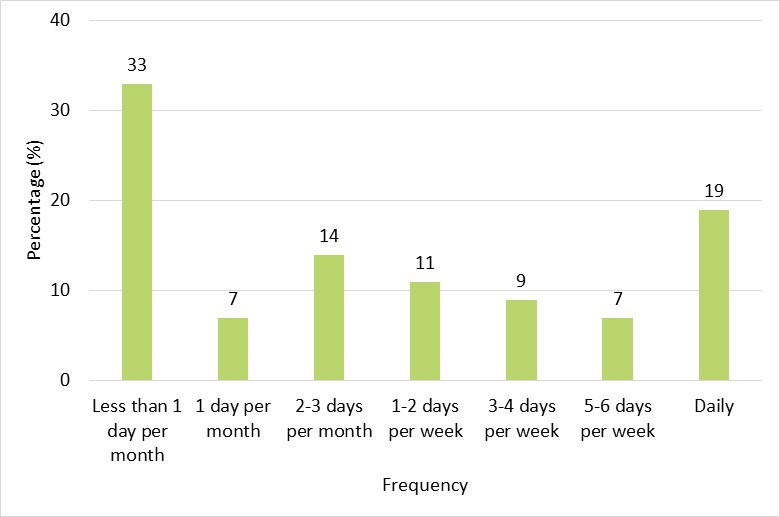
Text description
| Frequency | Percentage |
|---|---|
| Less than 1 day per month | 33% |
| 1 day per month | 7% |
| 2-3 days per month | 14% |
| 1-2 days per week | 11% |
| 3-4 days per week | 9% |
| 5-6 days per week | 7% |
| Daily | 19% |
Overall, a greater percentage of males (29%) reported daily or almost daily use compared to females (23%), whereas a greater percentage of females (38%) reported less than monthly use compared to males (28%). The distribution of daily or almost daily use by sex and age group is summarized in Figure 7. There were no significant differences in percentages reporting less than monthly use among age groups examined. Provincial/territorial estimates for daily or almost daily use ranged from 17% to 42% and estimates of less than monthly use ranged from 28% to 44%.
Figure 7: Frequency of daily or almost daily cannabis use in the past 12 months, by age group and sex, 2021
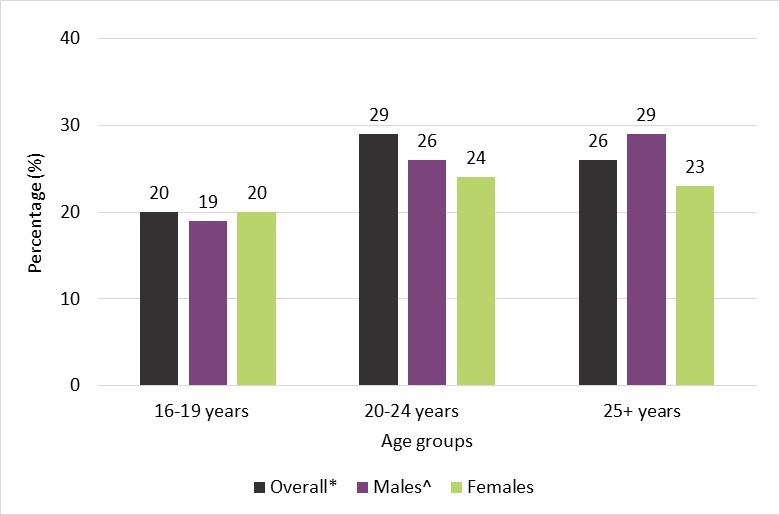
Text description
| 16-19 years | 20-24 years | 25+ years | |
|---|---|---|---|
| OverallFigure 7 Footnote * | 20% | 29% | 26% |
| MalesFigure 7 Footnote ∧ | 19% | 26% | 29% |
| Females | 20% | 24% | 23% |
|
|||
Overall, 17% of Canadians age 16 years and older reported using cannabis in the past 30 days (unchanged from 2020). When asked how many days they used cannabis within the past 30 days, the average number of days was 14.3 (unchanged from 2020). The majority reported using cannabis once a day on a typical use day (54%); the next most common responses were twice a day (20%) followed by five or more times per day (11%), all unchanged from 2020.
Number of hours "stoned" or "high" on a typical use day
People who had reported using cannabis in the past 30 days were asked about the number of hours they would spend "stoned" or "high" on a typical use day. Thirty-eight percent (38%, unchanged from 2020) reported they would be "stoned" or "high" on a typical use day for one or two hours, followed by three or four hours (33%, unchanged from 2020), less than one hour (15%, unchanged from 2020), five or six hours (10%, unchanged from 2020), and seven or more hours (5%, a decrease from 7% in 2020).
Frequency of cannabis use to get "high" before school or work
Those who indicated “going to school” as their main activity in the past week and who had used cannabis in the past 12 months were asked about the frequency of cannabis use to get "high" within two hours before or at school. Overall, 75% reported they had not used cannabis to get "high" before or at school in the past 12 months. Thirteen percent (13%) of students who used cannabis in the past 12 months reported rarely using cannabis before or at school (less than once a month), and 7% used cannabis before or at school weekly or more often. Most students (95%) reported never being absent from school because of their cannabis use. These were all unchanged from 2020.
The majority of people who reported using cannabis in the past 12 months had not used cannabis to get "high" within two hours before or at work in the past 12 months (68%), and a further 14% reported they had not been employed in the past 12 months. Eleven percent (11%) reported using cannabis before or at work rarely (less than once a month), and 4% used cannabis before or at work weekly or more often. Most people (81%) indicated they had not been absent from work as a result of their cannabis use and a further 17% stated they were not employed. These were all unchanged from 2020.
Methods of consumption
People who had reported using cannabis in the past 12 months were asked about their methods of consumption. Smoking (74%) was the most common method of cannabis consumption reported by people who used cannabis in the past 12 months, a decrease from 2020 (79%). Other methods of consumption were: eating it in food (54%), unchanged from 2020, vapourizing using a vape pen or e-cigarette (28%), an increase from 2020 (24%), cannabis oil for oral use (22%, new in 2021 survey), drinking it (15%), an increase from 2020 (7%), vapourizing using a vapourizer (10%), unchanged from 2020, applying to skin (9%), an increase from 2020 (5%), and dabbing (6%), unchanged from 2020.
When examining methods of consumption by province and the territories, the most common method of consumption in all regions was smoking (estimates ranged from 65% to 86%). This was followed by eating it in food (estimates ranged from 27% to 62%) and vapourizing using a vape pen (estimates ranged from 17% to 38%).
People who used cannabis in the past 12 months who used a vapourizer and/or vape pen were asked what cannabis product was used when vapourizing cannabis and the type of vaping device used. The most common cannabis product used was liquid cannabis oil/extract (68%, an increase from 60% in 2020), followed by dried flower/leaf (54%, a decrease from 65% in 2020), and solid cannabis extracts (20%, a decrease from 24% in 2020). The majority responded that they use a non-disposable vaping device (66%), a decrease from 2020 (72%), followed by 21% who used a disposable vaping device and 12% who used both disposable and non-disposable, both unchanged from 2020.
Types of cannabis products used and frequency
People who used cannabis in the past 12 months were asked about the types of cannabis products they had used in the past 12 months. People could select more than one product. The six most common products used in 2021 are summarized in Figure 8. Canadians were also asked about the frequency at which they used these cannabis products. The most commonly reported frequency for five of these products was less than one day a month, ranging from 28% for cannabis vape pens/cartridges to 62% for beverages. For dried flower/leaf the most common frequency was daily or almost daily (32%).
Figure 8: Past 12 months, cannabis products used1 among people who used cannabis in past 12 months, 2020 to 2021
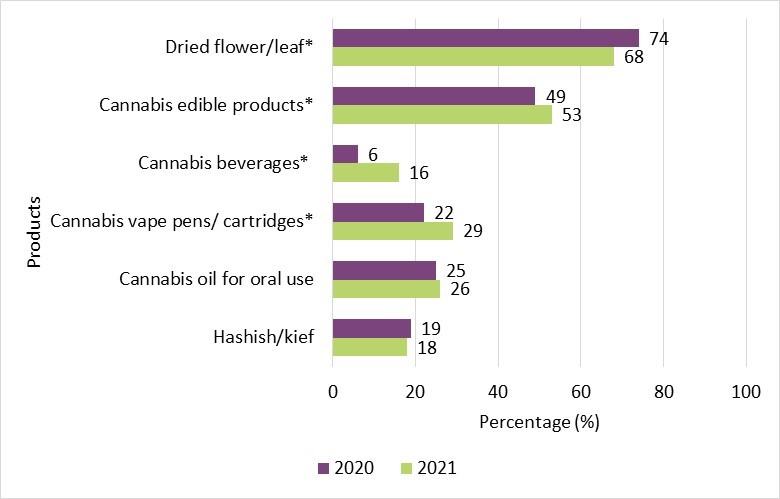
Text description
| ProductsFigure 8 Footnote 1 | 2020 | 2021 |
|---|---|---|
| Dried flower/leafFigure 8 Footnote * | 74% | 68% |
| Cannabis edible productsFigure 8 Footnote * | 49% | 53% |
| Cannabis beveragesFigure 8 Footnote * | 6% | 16% |
| Cannabis vape pens/cartridges | 22% | 29% |
| Cannabis oil for oral use | 25% | 26% |
| Hashish/kief | 19% | 18% |
|
||
A higher percentage of males reported using dried flower (74%), hash (22%), and concentrates/extracts (15%), compared to females (61%, 14%, and 8%, respectively). A higher percentage of females reported using edibles (58%) and topicals (12%) when compared to males (49% and 7%, respectively). The percentage reporting use of vape pens/cartridges, cannabis oil for oral use, and cannabis beverages was the same for both males and females (approximately 29%, 26%, and 16%, respectively).
In all provinces and the territories, the most common product used was dried flower/leaf, ranging from 61% to 75%. Edibles were the second most commonly reported products (estimates ranged from 53% to 60%), except in Quebec (26%). In Quebec, the second most commonly reported product was cannabis oil for oral use (28%).
Relative levels of THC and CBD in cannabis products
People who used cannabis in the past 12 months were asked about the relative levels of THC and CBD in the cannabis products they typically use. Twenty-nine percent (29%, unchanged from 2020) indicated higher THC and lower CBD, 13% (an increase from 11% in 2020) indicated higher CBD and lower THC, and 11% selected equal levels of THC and CBD, 7% selected THC only, 3% selected CBD only, and 16% said they typically used a mix of these products, all unchanged from 2020. Twenty percent (20%) indicated they did not know the relative levels of THC and CBD, a decrease from 25% in 2020.
Average amount used on a typical use day
People who had used cannabis in the past 12 months were asked about the average amount of cannabis used on a typical use day. Of those who had used dried flower/leaf, the average amount used on a typical use day was 1.1 grams, unchanged from 2020. Those who used edible cannabis products consumed approximately 1.3 servings, also unchanged from 2020. The average amount of cannabis oil for oral use used was 0.8 millilitres, a decrease from 1.0 in 2020. Of those who used each of the following products, the average amount used on a typical day was 0.4 grams of hashish/kief, 0.1 cartridges for vape pens, approximately 365 millilitres of beverages, and 0.2 grams of cannabis concentrate/extract, all unchanged from 2020.
Cannabis use with other substances
People who had used cannabis in the past 12 months were asked how often they combined their cannabis use with other substances, by mixing or consuming at the same time. People could select more than one substance. Alcohol was the substance most commonly used in combination with cannabis followed by tobacco (Figure 9). The majority of Canadians never combined cannabis use with illegal opioids (99%), prescription stimulants (96%), prescription opioids (95%), prescription sedatives (95%), illegal stimulants (96%), or illegal hallucinogens/dissociatives (91%).
Figure 9: Past 12 months, use of alcohol and tobacco1 in combination2 with cannabis, among people who used cannabis in the past 12 months, 2021
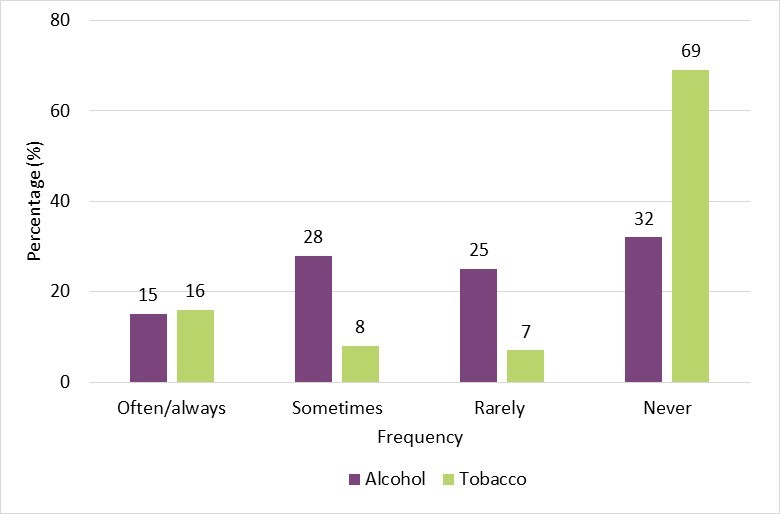
Text description
| FrequencyFigure 9 Footnote 1Figure 9 Footnote 2 | Alcohol | Tobacco |
|---|---|---|
| Often/always | 15% | 16% |
| Sometimes | 28% | 8% |
| Rarely | 25% | 7% |
| Never | 32% | 69% |
|
||
Effects of cannabis use
People who used cannabis in the past 12 months were asked about the effects of their cannabis use on various aspects of their lives (Figure 10). The percentage reporting somewhat to very harmful effects was 10% or less across all categories.
Figure 10: Past 12 months, effects of cannabis use, among people who used cannabis in the past 12 months, 2021
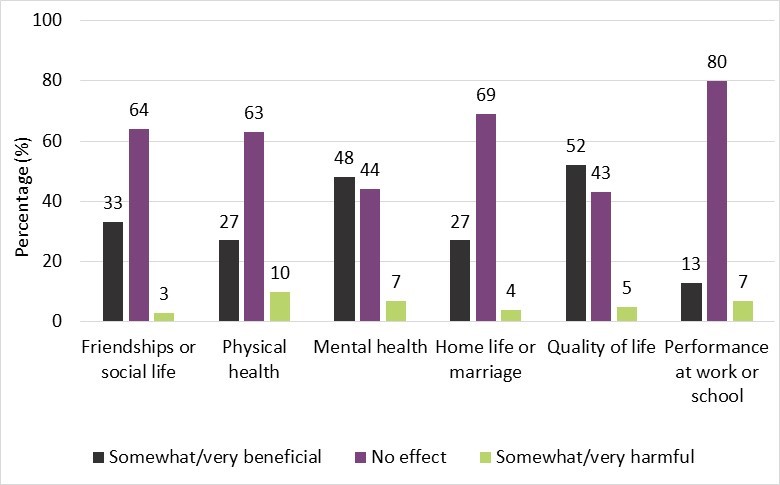
Text description
| Somewhat/very beneficial | No effect | Somewhat/very harmful | |
|---|---|---|---|
| Friendships or social life | 33% | 64% | 3% |
| Physical health | 27% | 63% | 10% |
| Mental health | 48% | 44% | 7% |
| Home life or marriage | 27% | 69% | 4% |
| Quality of life | 52% | 43% | 5% |
| Performance at work or school | 13% | 80% | 7% |
Professional help for cannabis use
Most people (96%) who had used cannabis more than once in their lifetime reported they never felt they needed professional help (such as treatment or counselling) for their cannabis use, unchanged from 2020. Only 2% reported ever having received professional help, unchanged from 2020.
Where cannabis is stored inside the home
People who had used cannabis in the past 12 months were asked about where they store cannabis inside the home. Among those who currently had cannabis stored at home, the most common storage locations included unlocked cabinets or drawers (36%); childproof containers (28%); locked containers (20%); and open shelves or tables (17%), all unchanged from 2020.
Willingness to disclose cannabis use
People who had used cannabis in the past 12 months were asked if they would be more willing to publicly disclose their cannabis use now that it is legal. Fifty-eight percent (58%) reported they would be more willing to publicly disclose whether they use cannabis, an increase from 51% in 2020. Twenty-one percent (21%) said they were already willing to disclose whether they use cannabis (a decrease from 25% in 2020) and 16% said they would not be more willing to say if they use cannabis, a decrease from 18% in 2020.
Sources and purchasing
Canadians who reported using cannabis for non-medical purposes were asked detailed questions about their use of cannabis. Topics included:
- sources used to obtain cannabis
- average amount spent each month
- type and frequency of cannabis products purchased or received
- average price per unit of purchases
- proportion of people who receive cannabis products for free
Sources used to obtain the cannabis product
People who reported using cannabis in the past 12 months were asked from whom they usually obtained cannabis in the past 12 months. Fifty-three percent (53%) reported they had made a purchase from a legal storefront, an increase from 41% in 2020. Figure 11 displays the sources used to obtain cannabis.
Figure 11: Past 12 months, from whom cannabis was usually obtained among people who used cannabis in the past 12 months, 2020 to 2021
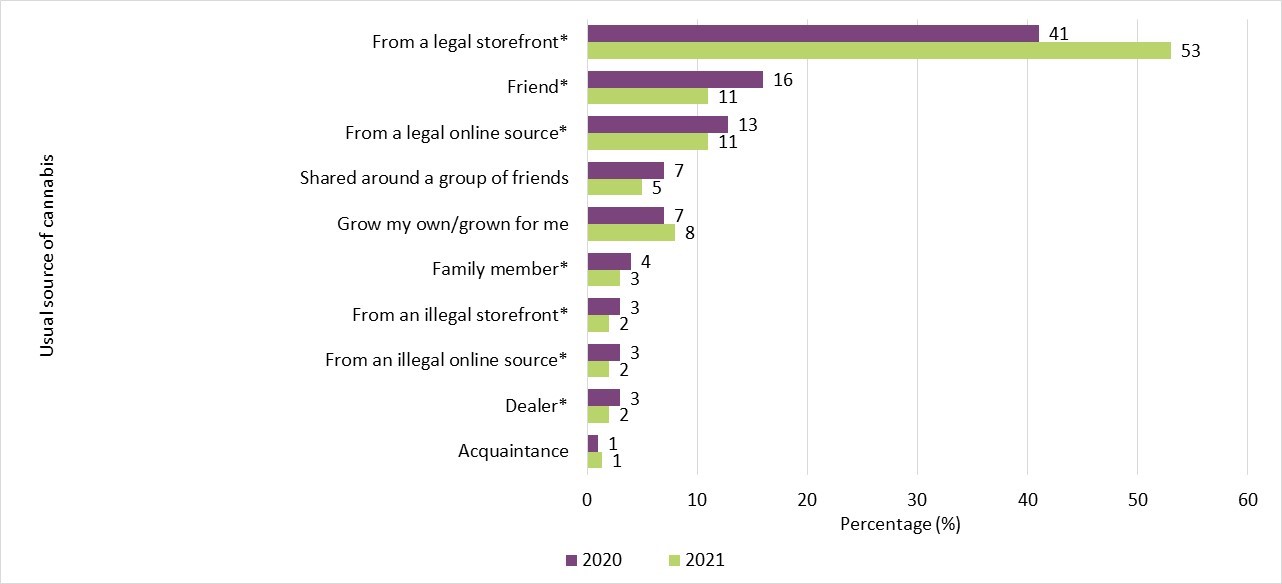
Text description
| Usual source of cannabis | 2020 | 2021 |
|---|---|---|
| From a legal storefrontFigure 11 Footnote * | 41% | 53% |
| FriendFigure 11 Footnote * | 16% | 11% |
| From a legal online sourceFigure 11 Footnote * | 13% | 11% |
| Shared around a group of friends | 7% | 5% |
| Grow my own/grown for me | 7% | 8% |
| Family memberFigure 11 Footnote * | 4% | 3% |
| From an illegal storefrontFigure 11 Footnote * | 3% | 2% |
| From an illegal online sourceFigure 11 Footnote * | 3% | 2% |
| DealerFigure 11 Footnote * | 3% | 2% |
| Acquaintance | 1% | 1% |
|
||
Those who used cannabis in the past 12 months were asked how often they purchased any cannabis from legal/licensed sources and from illegal/unlicensed sources (Figure 12). A higher percentage (43%) indicated they always obtain from a legal/licensed source in 2021 than in 2020 (37%). There was also a higher percentage (63%) indicating they never obtain from an illegal/unlicensed source in 2021 compared to 2020 (55%).
Figure 12: Past 12 months, frequency of obtaining cannabis from an illegal/unlicensed or legal/licensed source, among people who used cannabis in the past 12 months, 2021
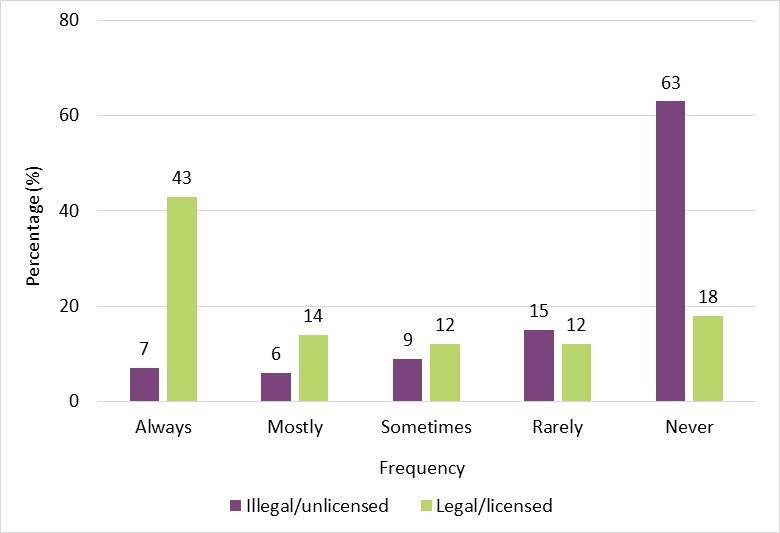
Text description
| Frequency | Illegal/unlicensed | Legal/licensed |
|---|---|---|
| Always | 7% | 43% |
| Mostly | 6% | 14% |
| Sometimes | 9% | 12% |
| Rarely | 15% | 12% |
| Never | 63% | 18% |
Canadians who used cannabis in the past 12 months who obtained cannabis from a legal/licensed source were asked to identify all sources used. People could select more than one source. Responses included using a regulated/authorized storefront (81%, an increase from 71% in 2020), a regulated/authorized online retailer (28%), and growing at home (6%), both unchanged from 2020. Twenty percent (20%, a decrease from 35% in 2020) reported their source came from someone sharing, and of those Canadians, 19% of them paid the person that shared with them, unchanged from 2020. Seventy-three percent (73%, unchanged from 2020) indicated that there was no change in access to legal/licensed cannabis due to the COVID-19 pandemic.
Canadians who used cannabis in the past 12 months who obtained cannabis from an illegal/unlicensed source were asked to identify all sources used. People could select more than one source. Reponses included buying from someone they knew (59%), an unregulated/unauthorized online retailer (20%), from a dealer (20%), all unchanged from 2020, and an unregulated/unauthorized storefront (11%, a decrease from 19% in 2020). Seventy-five percent (75%, unchanged from 2020) indicated that there was no change in access to illegal/unlicensed cannabis due to the COVID-19 pandemic.
People who used cannabis in the past 12 months were asked how often a cannabis product they intended to buy from a provincially regulated retailer was unavailable. The most common response was never (37%), followed by sometimes (22%), rarely (21%), often (7%) and always (5%). Nine percent (9%) reported that they never intended to buy from a provincially regulated retailer. People were also asked to rank which factors most influenced who they usually obtain cannabis from. The three factors with the highest percentage of first priority ranking were price (28%), safe supply (26%) and quality (14%) (Figure 13).
Figure 13: Factors that most influenced from whom cannabis was obtained, among people who used cannabis in the past 12 months, 2021
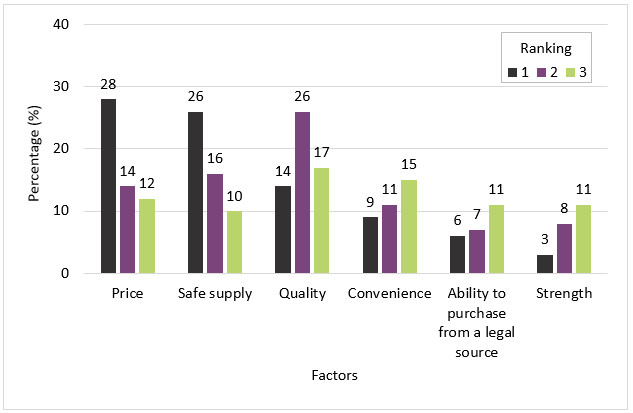
Text description
| Factors | Rank | ||
|---|---|---|---|
| 1 | 2 | 3 | |
| Price | 28% | 14% | 12% |
| Safe supply | 26% | 16% | 10% |
| Quality | 14% | 26% | 17% |
| Convenience | 9% | 11% | 15% |
| Ability to purchase from a legal source | 6% | 7% | 11% |
| Strength | 3% | 8% | 11% |
Average amount spent on cannabis each month
People who had used cannabis in the past 12 months indicated typically spending close to $69 on cannabis products each month, unchanged from 2020. On average, females reported spending less on cannabis than males ($59 and $76, respectively).
People who had used cannabis in the past 30 days were asked how much they spent on cannabis from legal or illegal sources in the past 30 days. People reported spending approximately $55 (unchanged from 2020) in the past 30 days to obtain cannabis from legal sources, and $31 from illegal sources, a decrease from $47 in 2020.
When looking at spending by province and territories, those who used cannabis in the past 12 months indicated typically spending as little as $41 on cannabis products each month to as much as $91. Depending on where they lived, people who used cannabis in the past 30 days reported spending between $33 and $83 in the past 30 days to obtain cannabis from legal sources, compared to between $19 and $37 to obtain cannabis from illegal sources.
Cannabis products bought or received, and at what frequency
People who had used cannabis in the past 30 days were asked about the cannabis products they bought or received in the past 30 days and the frequency of these two occurrences. The most common response options selected were buying or receiving dried flower/leaf (66%, a decrease from 71% in 2020), followed by edibles (30%, unchanged from 2020). Vape pens (18%, an increase from 11% in 2020), cannabis oil for oral use (14%), hashish/kief (8%), and concentrates/extracts (7%) were all unchanged from 2020. Cannabis beverages (7%) increased from 2020 (3%), as did topicals (3% in 2021 and 2% in 2020). For all products, the most common frequency of obtaining them was one day per month.
The average amount purchased in the past 30 days varied by product type. On average, people who used cannabis in the past 30 days purchased or received 17 grams of dried flower/leaf, 7 servings of edibles, 2 cannabis cartridges/vape pens, and 17 millilitres of cannabis oil for oral use, all unchanged from 2020.
Average price per unit of purchases, by product type
People who had purchased cannabis in the past 30 days reported the average price per unit by product type. Over the past 30 days, people spent the most per unit on cannabis cartridges/vape pens $40.93/cartridge (a decrease from $47.18 in 2020) and concentrates and extracts ($35.30/gram), unchanged from 2020. The average price per unit for the more frequently used product types was $9.78 per gram of dried flower/leaf and $8.32 per serving for edibles, both unchanged from 2020.
Proportion of people who use cannabis and receive cannabis products for free
Of the Canadians who had obtained cannabis in the past 30 days, some reported receiving cannabis products for free. Overall, 13% of Canadians obtained free edibles, unchanged from 2020, and 11% obtained free dried flower/leaf, unchanged from 2020.
Driving and cannabis
People who had used cannabis in the past 12 months for non-medical purposes were asked about their driving habits relative to cannabis use and cannabis use in combination with alcohol or other drugs. Canadians were asked if they had ever been a passenger in a vehicle driven by someone within two hours of using cannabis, and for their opinions on cannabis and driving. The results presented under “Driving and cannabis” refer specifically to people who reported using cannabis for non-medical purposes.
People who operated a vehicle after using cannabis, and at what frequency
The CCS specifically looked at driving after using cannabis. Canadians were asked about both driving within two hours of smoking/vapourizing cannabis or a cannabis product and about driving within four hours of ingesting a cannabis product. Canadians were also asked about the type of cannabis product used prior to driving after smoking/vapourizing cannabis or ingesting a cannabis product.
Among people who had used cannabis in the past 12 months, 21% reported that they had ever driven within two hours of smoking or vapourizing cannabis, unchanged from 2020. Thirty-five percent (35%) did so within the past 30 days and 29% within the past 12 months (both unchanged from 2020), while 36% did so more than 12 months ago (an increase from 29% in 2020). This behaviour was more prevalent among males and those 20 to 24 years and 25 years and older (Figure 14). The most common types of cannabis products smoked or vaped within two hours of driving were THC predominant (37%) and THC only (34%). Provincial and territorial estimates of ever driven within two hours of smoking or vapourizing cannabis ranged from 13% to 34%. Estimates on how recently this occurred are suppressed for most regions due to the small sample size.
Among people who had used cannabis in the past 12 months, 13% reported that they had ever driven within four hours of ingesting a cannabis product, unchanged from 2020. Twenty-nine percent (29%) did so within the past 30 days, 39% within the past 12 months, and 32% more than 12 months ago. This behaviour was more prevalent among males and those 25 years and older (Figure 14). The most common types of cannabis products ingested within four hours of driving were THC predominant (35%) and THC only (29%).
Figure 14: Ever driven a vehicle within two hours of smoking or vaping cannabis, and/or within four hours of ingesting a cannabis product, among people who used cannabis in the past 12 months, by sex and age group, 2021
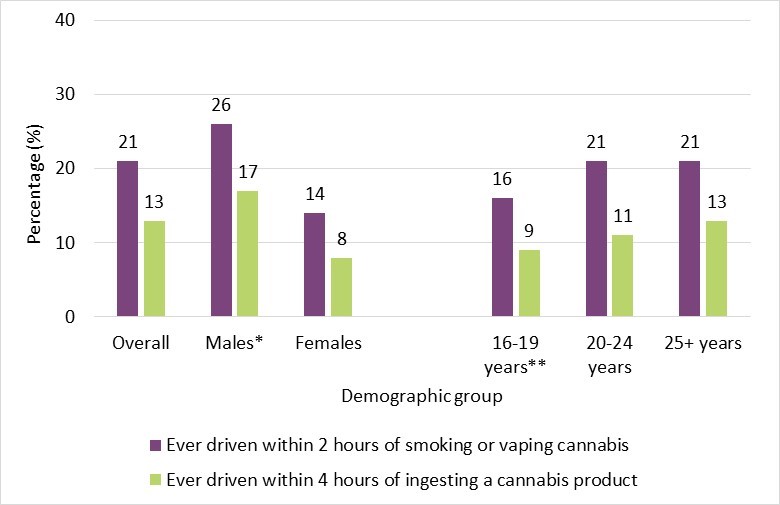
Text description
| Demographic group | Ever driven within 2 hours of smoking or vaping cannabis | Ever driven within 4 hours of ingesting a cannabis product |
|---|---|---|
| Overall | 21% | 13% |
| MalesFigure 14 Footnote * | 26% | 17% |
| Females | 14% | 8% |
| 16-19 yearsFigure 14 Footnote ** | 16% | 9% |
| 20-24 years | 21% | 11% |
| 25+ years | 21% | 13% |
|
||
People who operated a vehicle within two hours of using cannabis in combination with alcohol or other drugs
People who indicated they had ever driven within two hours of smoking/vapourizing cannabis or within four hours of ingesting cannabis were also asked if they drove a vehicle within two hours of using cannabis in combination with alcohol. Eighteen percent (18%, unchanged from 2020) of them reported that they had driven a vehicle within two hours of using cannabis in combination with alcohol. Of those who had driven after using cannabis in combination with alcohol, 28% did so within the past 30 days, 25% within the past 12 months, and 48% more than 12 months ago.
The same people were also asked if they drove a vehicle within two hours of using cannabis in combination with other drugs. Ten percent (10%, unchanged from 2020) of them reported that they had driven a vehicle within two hours of using cannabis in combination with other drugs.
Reasons people operated a vehicle after recent use of cannabis
People who indicated they had ever driven within two hours of smoking/vapourizing cannabis or within four hours of ingesting cannabis were asked why they drove after using cannabis. People were allowed to select more than one reason. The most common reason was because the person did not feel impaired (78%), followed by they thought they could drive carefully (22%), did not have far to drive (20%), no alternative transportation (13%), did not think they would be caught by law enforcement (9%), and other reasons (8%). All unchanged from 2020.
People who were passengers in a vehicle driven by someone within two hours of using cannabis
Canadians were asked if they had ever been a passenger in a vehicle driven by someone who had used cannabis within the previous two hours. Overall, 22% of people reported having ever been a passenger in a vehicle driven by someone who had recently used cannabis, unchanged from 2020. This behaviour was more common among those who used cannabis in the past 12 months (50%) compared to those who did not use cannabis (13%), both unchanged from 2020. The immediacy of this behaviour, among people who indicated using cannabis in the past 12 months, ranged from within the past 30 days (18%, unchanged from 2020), within the past 12 months (25%, a decrease from 32% in 2020), to more than 12 months ago (58%, an increase from 50% in 2020). For those who did not use cannabis in the past 12 months, 6% reported being a passenger in a vehicle driven by someone who had recently used cannabis in the past 30 days, 13% in the past year, and 81% reported this happening more than 12 months ago, all unchanged from 2020.
Provincial and territorial estimates of ever being a passenger in a vehicle driven by someone who had used cannabis within two hours of driving ranged from 19% to 34%.
Interaction with law enforcement related to driving
Two percent (2%) of people who had used cannabis in the past 12 months reported having an interaction with law enforcement related to driving under the influence of cannabis while they were the driver of a vehicle, unchanged from 2020.
Opinions on cannabis use and driving
People were asked for their opinions on how cannabis use affects driving. More than eight in ten (83%) people reported that they think that cannabis use affects driving, unchanged from 2020. This dropped to 78% (unchanged from 2020) when looking at responses from those who reported using cannabis in the past 12 months. Thirteen percent (13%) of those who reported using cannabis in the past 12 months responded that it depends, or that it did not affect driving (7%), both unchanged from 2020.
New in the 2021 survey, people were asked for their opinion on the time it takes until it is safe to drive after different methods of consuming cannabis. They were first asked when it would be safe to drive after inhaling (smoking/vaping) cannabis and then when it would be safe to drive after ingesting (eating/drinking cannabis). When asked about when it would be safe to drive after inhaling cannabis the five most common responses were “don’t know” (34%), 8 or more hours (21%), 3 hours to just under 5 hours (15%), 5 hours to just under 7 hours (12%), and 7 hours to just under 8 hours (6%). Only 2% indicated it would be safe to drive immediately after inhaling cannabis. When asked about when it would be safe to drive after ingesting cannabis the five most common responses were “don’t know” (37%), 8 or more hours (30%), 5 hours to just under 7 hours (10%), 7 hours to just under 8 hours (9%), and 3 hours to just under 5 hours (7%). Only 2% indicated it would be safe to drive immediately after ingesting cannabis.
Opinions on likelihood of being caught driving under the influence
Canadians were asked how likely they thought it was that a person would be caught by police if they drove under the influence of alcohol or under the influence of cannabis. Likelihood was determined using a 5-point Likert scale, which had the following categories: not at all likely, not likely, somewhat likely, likely, and extremely likely.
Among all people, the most common response for both being caught driving under the influence of alcohol and driving under the influence of cannabis was ‘somewhat likely’ (41% and 40%, respectively). However, 44% of people indicated likely, or extremely likely when asked about a driver being caught driving under the influence of alcohol. This is higher than the 25% of people indicating likely, or extremely likely when asked about a driver being caught driving under the influence of cannabis. All unchanged from 2020.
Cannabis for medical purposes
Canadians who indicated they had used cannabis in the past 12 months for medical purposes were asked if they would complete an additional section of the survey related to this use. Questions related to the source of the product, type of product, frequency of use, type of strain, how much was used in a typical day, diseases and symptoms addressed by cannabis use, and changes in use of other medications as a result of cannabis use. Of the 1,540 respondents who indicated they had used cannabis for medical purposes in the past 12 months, 844 agreed to complete the medical use section of the survey. The results presented under “Cannabis for medical purposes” refer specifically to people who reported using cannabis for medical purposes in the past 12 months.
Medical use
People were asked about their cannabis use in the past 12 months. Fourteen percent (14%) of Canadians aged 16 years and older indicated that they used cannabis for medical purposes, unchanged from 2020. Provincial and territorial estimates ranged from 7% to 19%.
Seventy-four percent (74%) of people who used cannabis in the past 12 months for medical purposes and who completed the medical section of the survey reported using cannabis in the past 30 days for medical purposes, unchanged from 2020.
Possession of medical documents
When we asked people if they used cannabis for medical purposes in the past 12 months, they were asked to specify whether this use was with or without documentation from a healthcare professional. Three percent (3%) of Canadians aged 16 years and older, or 22% of those who used cannabis for medical purposes, said they did so with a document from a healthcare professional. The majority (78%) did not have a document from a healthcare professional. These percentages were unchanged from 2020.
Changes in use of other medications
Canadians who completed the medical section of the survey were asked if cannabis use for medical purposes allowed them to decrease their use of other medications. The majority of people reported that cannabis use helped decrease their use of other medications (52%, a decrease from 57% in 2020). Twenty-five percent (25%, an increase from 20% in 2020) reported that this question was not applicable.
Frequency of cannabis use for medical purposes
People who completed the medical section of the survey were asked about the frequency they used cannabis for medical purposes in the past 12 months. The most common frequency reported was daily (32%) use of cannabis, unchanged from 2020. Less than one day per month increased to 19% from 14% in 2020. All other frequencies of cannabis use were unchanged from 2020. (Figure 15).
Figure 15: Frequency of cannabis use for medical purposes in the past 12 months, 2021
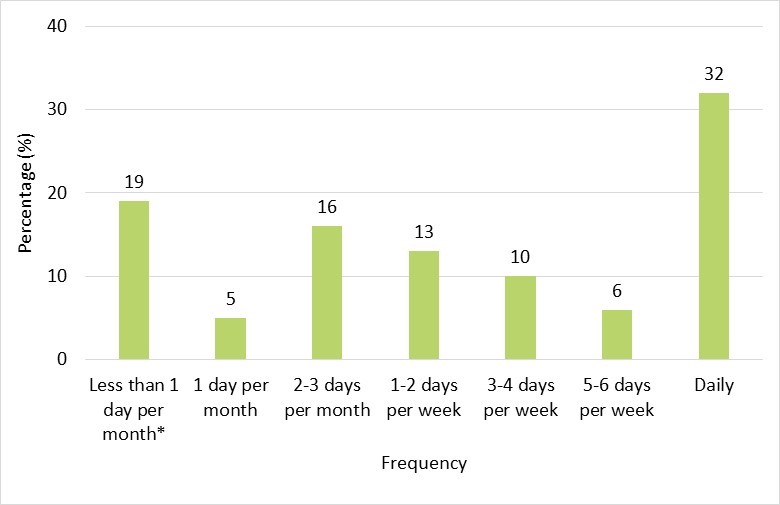
Text description
| Frequency | Percentage |
|---|---|
| Less than 1 day per monthFigure 15 Footnote * | 19% |
| 1 day per month | 5% |
| 2-3 days per month | 16% |
| 1-2 days per week | 13% |
| 3-4 days per week | 10% |
| 5-6 days per week | 6% |
| Daily | 32% |
|
|
Types of cannabis products used for medical purposes
People who completed the medical section were asked about the types of cannabis products they used within the last year. The three main products used were dried flower/leaf (50%), cannabis oil for oral use (49%), and edibles (31%), all unchanged from 2020). Other products reported by these Canadians included topical ointments (20%, unchanged from 2020); cannabis cartridges/vape pens (18%, an increase from 14% in 2020); beverages (9%, an increase from 4% in 2020); concentrates and extracts (9%, unchanged from 2020); and hashish/kief (8%, unchanged from 2020).
Those who were 20 to 24 years old (69%) had a higher prevalence of using dried flower/leaf than those 25 years and older (48%). Males also had a higher percentage of using dried flower/leaf than females (60% and 43%, respectively).
Those who completed the medical section were also asked about the frequency at which they used these cannabis products. Dried flower/leaf had a variety of responses, which ranged from daily/almost daily use (46%), weekly use (23%), monthly use (19%), and less than one day a month (12%), all unchanged from 2020. Cannabis oil for oral use also had a variety of responses, which ranged from less than one day a month (22%), monthly use (25%), weekly use (21%), and daily/almost daily use (31%), also all unchanged from 2020.
Relative levels of THC and CBD in cannabis products used for medical purposes
People who completed the medical section of the survey were asked about the relative levels of THC and CBD in the cannabis products they typically use. Twenty-five percent (25%) indicated higher CBD and lower THC, 19% selected higher THC and lower CBD, 16% indicated equal levels of THC and CBD (an increase from 12% in 2020), 17% indicated using CBD only products, and 11% indicated they used a mix of different products. Nine percent (9%) indicated they did not know the relative levels of THC and CBD, unchanged from 2020.
Average amount used on a typical use day for medical purposes
People who completed the medical section of the survey were also asked to report the average amount of cannabis used on a typical use day. Of those who had used dried flower/leaf, the average amount used on a typical use day was 1.7 grams (unchanged from 2020) whereas those who used edible cannabis products consumed approximately 1.3 servings (unchanged from 2020); cartridges/vape pens, 0.1 cartridges, (unchanged from 2020); hashish, 0.9 grams, (unchanged from 2020); and beverages, 382 millilitres, (unchanged from 2020). Among those who used cannabis oil for oral use, the average amount used was 1.1 millilitres (a decrease from 1.4 millilitres in 2020), and for concentrates/extracts, the average amount was 0.3 grams, unchanged from 2020.
Sources used to obtain cannabis products for medical purposes
People who completed the medical section of the survey were asked where they obtained cannabis for medical purposes (Figure 16). Canadians could select multiple sources. In 2021, the top five sources to obtain cannabis for medical purposes were from a legal storefront (53%, an increase from 44% in 2020); a legal online source (38%, an increase from 23% in 2020); a Health Canada licensed producer (21%, unchanged from 2020); a friend (11%, a decrease from 17% in 2020); and growing their own or having it grown for them (13%, unchanged from 2020). Of those who obtained cannabis from a Health Canada licensed producer, 77% reported they will continue to access cannabis from a licensed producer now that legal retail sales for non-medical cannabis are available (unchanged from 2020).
Figure 16: Past 12 months, from whom cannabis was usually obtained1 among past 12-month medical users, 2021
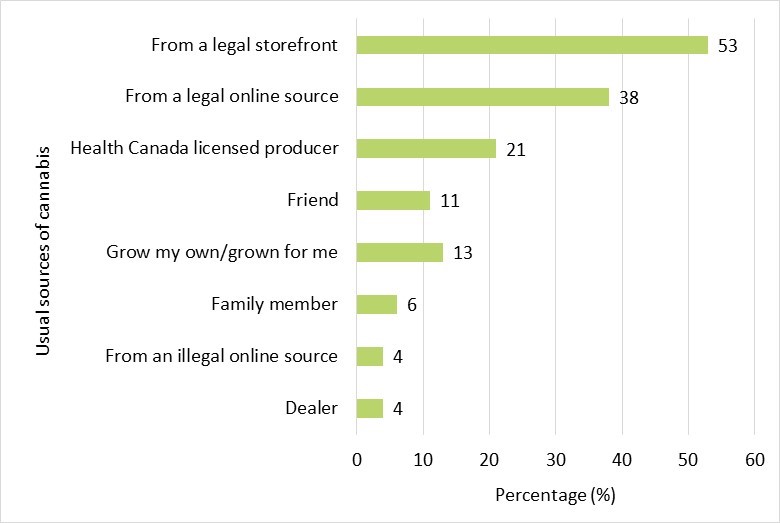
Text description
| Usual sources of cannabisFootnote 1 | Percentage |
|---|---|
| From a legal storefront | 53% |
| From a legal online source | 38% |
| Health Canada licensed producer | 21% |
| Friend | 11% |
| Grow my own/grown for me | 13% |
| Family member | 6% |
| From an illegal online source | 4% |
| Dealer | 4% |
|
|
Average amount spent on cannabis for medical purposes in a typical month
People who used cannabis for medical purposes in the past 12 months and who completed the medical section of the survey spent approximately $81 (unchanged from 2020) on cannabis for medical purposes in a typical month. People who used cannabis for medical purposes in the past 30 days were asked how much they spent on cannabis in the past 30 days from both legal and illegal sources. The average amount spent on cannabis from legal sources was $77 (unchanged from 2020); and the average amount spent on cannabis from illegal sources was $22, a decrease from $42 in 2020.
We also asked if people currently had insurance coverage for cannabis for medical purposes. Most people (91%, unchanged from 2020) did not have any insurance coverage. Five percent (5%) indicated they had full insurance coverage and a further 4% said they were partially covered, both unchanged from 2020.
Cannabis products for medical purposes bought or received, and at what frequency
People who used cannabis for medical purposes in the past 30 days were asked about the cannabis products they bought or received in the past 30 days and the frequency of these occurrences. The most common response options selected were buying or receiving dried flower/leaf (47%, unchanged from 2020) followed by cannabis oil for oral use (40%, unchanged from 2020), and edibles (22%, unchanged from 2020). For all products, the most common frequency of obtaining them was one day per month.
The average amount purchased for medical use in the past 30 days varied by product type. On average, people who used cannabis purchased or received 16.2 grams of dried flower/leaf, 8.9 servings of edibles, and 1.7 cartridges/vape pens, all unchanged from 2020. For cannabis oil for oral use, the average quantity obtained was 22.8 millilitres (unchanged from 2020).
Average price per unit of cannabis purchases for medical purposes, by product type
People who purchased cannabis for medical purposes in the past 30 days also reported the average price per unit by product type. Over the past 30 days, people who used cannabis for medical purposes spent the most per unit on cannabis cartridges/vape pens ($34.94/cartridge, a decrease from $51.06 in 2020). For the more commonly purchased products the average price per unit were $10.32 per gram for dried flower, $5.87 per serving for edibles, and $13.62 per millilitre for cannabis oil for oral use, all unchanged from 2020.
Opinions on cannabis use for medical purposes and driving
People who completed the medical section of the survey were asked if they believed that cannabis use for medical purposes impairs one's ability to drive. More of these people reported that 'yes', cannabis use for medical purposes impairs one's ability to drive (49%), compared to those who reported 'no' (18%) and 'it depends' (26%), all unchanged from 2020. The same people were also asked for their opinion on the time until it was safe to drive after using cannabis for medical purposes. The most common responses were three to five hours (20%), don't know (18%), eight or more hours (15%), and one to three hours (13%), all unchanged from 2020. Four percent (4%, a decrease from 8% in 2020) of these people indicated that it was safe to drive immediately after cannabis use for medical purposes.
Driving a vehicle after using cannabis for medical purposes, and at which frequency
Driving after using cannabis for medical purposes was studied among people who completed the medical section of the survey. The questions about driving after recent cannabis use were split based on the method of cannabis use. People were asked if they had ever driven within two hours of smoking or vapourizing cannabis and also if they had ever driven within four hours of orally ingesting cannabis. Overall, 16% reported they had ever driven within two hours of smoking or vapourizing cannabis (unchanged from 2020). Of those who had driven after smoking or vapourizing cannabis, 47% did so within the past 30 days, 32% within the past 12 months, and 21% more than 12 months ago, all unchanged from 2020. When asked about driving within four hours of ingesting cannabis, 12% reported doing so in their lifetime (unchanged from 2020). For those who had driven after ingesting cannabis, 46% reported doing so within the past 30 days and 33% within the past 12 months, both unchanged from 2020.
A greater proportion of males (24%) reported driving within two hours of smoking or vapourizing cannabis for medical purposes compared to females (10%). This pattern persisted for driving within four hours of ingesting cannabis (17% and 9%, respectively).
Featured topics:
The Cannabis Act came into effect on October 17, 2018. Key findings on cannabis use for non-medical purposes from 2018, 2019, 2020 and 2021 are compared to examine self-reported changes since legalization and regulation.
Methods
The CCS uses a two-step recruitment process. First, respondents are recruited by phone (land line or mobile) from lists of random telephone numbers. Respondents who pass a set of screening questions are then sent a link to an online survey, either by email or short message service (SMS) to their mobile phones. The average time to fill out the 2021 CCS was 26 minutes for respondents who reported using cannabis within the past 12 months and 13 minutes for respondents who reported that they had not used cannabis.
This summary presents survey findings from the fourth data collection cycle, which started April 7, 2021 and ended June 28, 2021. Survey findings were weighted by province, age groups, and sex at birth. For the 108 people who were missing a response for both sex at birth and gender, no weights were attributed. Cases where a weight could not be attributed were excluded from national estimates but remain in the data set. Survey results are based on responses from 10,736 respondents aged 16 years and older across all provinces and territories where weights could be created. For additional details refer to the Methodological report published on the Library and Archives website.
The CCS was designed to obtain a sufficient number of respondents from key sub-populations. To ensure statistical relevance of results and representativeness, minimum sample sizes were determined and met for these sub-populations. Of the responses received, approximately 3,900 were from people who indicated that they had used cannabis in the past 12 months for either non-medical or medical purposes. Table 1 summarizes the sample size represented by the survey.
| Females | Males | 16-19 years | 20-24 years | 25+ years | Total | |
|---|---|---|---|---|---|---|
| Canada | 5,722 | 5,014 | 985 | 1,228 | 8,523 | 10,736 |
| Newfoundland and Labrador | 252 | 201 | 28 | 27 | 398 | 453 |
| Prince Edward Island | 259 | 162 | 23 | 21 | 377 | 421 |
| Nova Scotia | 263 | 204 | 40 | 43 | 384 | 467 |
| New Brunswick | 219 | 197 | 30 | 28 | 358 | 416 |
| Québec | 1,070 | 863 | 174 | 350 | 1,409 | 1933 |
| Ontario | 1,602 | 1,437 | 336 | 404 | 2,299 | 3,039 |
| Manitoba | 215 | 211 | 33 | 27 | 366 | 426 |
| Saskatchewan | 229 | 200 | 23 | 35 | 371 | 429 |
| Alberta | 721 | 682 | 124 | 120 | 1,159 | 1,403 |
| British Columbia | 791 | 760 | 151 | 164 | 1,236 | 1,551 |
| TerritoriesTable 1 Footnote 1 | 101 | 97 | 23 | 9 | 166 | 198 |
|
||||||
Considerations
Coronavirus disease 2019 (COVID-19) is a novel infectious respiratory illness. In March 2020, the World Health Organization declared COVID-19 a pandemic. Across Canada, public health measures were implemented, which included physical distancing from people other than those in your own household, in order to slow the spread of new cases. In 2021, many of the public health measures continue and have changed daily routines. These changes may have caused a change in behaviour related to cannabis use, including the amount of cannabis used, accessing sources of cannabis and the amount of money spent on cannabis.
Questions were added to the 2020 and 2021 surveys to understand the impact of COVID-19 on cannabis use.
When recruited, respondents were informed that the survey was about cannabis. This information may have created a participation bias in that those who use cannabis may have been more likely to complete the survey. For this and other methodological reasons, the CCS may provide prevalence estimates for cannabis use that are higher than other Canadian population level surveys.
As a result, Health Canada estimates the prevalence of cannabis use in the general population through two different surveys. The Canadian Tobacco, Alcohol and Drugs Survey (CTADS) and the Canadian Student Tobacco, Alcohol and Drugs Survey (CSTADS) are designed specifically to measure prevalence. CTADS 2017 indicates that 15% of Canadians age 15 and older (or 4.4 million) have used cannabis in the past 12 months (19% among age 15 to 19 years; 33% among age 20 to 24 years; and 13% among age 25 years and older). CSTADS 2018/19 indicates that 18% of students in grades 7 to 12 (approximately 374,000) have used cannabis in the past 12 months.
Additional Links
Page details
- Date modified: